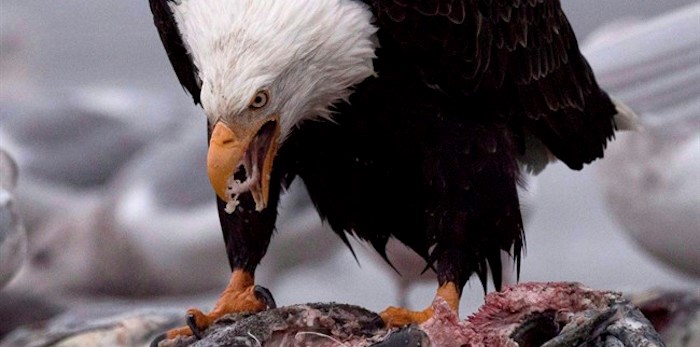Along the Harrison River in British Columbia thousands of eagles are gathering to gorge on salmon that have reached the spawning ground.
David Hancock, a biologist who has been studying eagles for about 65 years, says the world's largest congregation of bald eagles happens on the river in the little community of Harrison Mills, about 100 kilometres east of Vancouver.
 Where the Harrison River in British Columbia runs deep and the mountains stand tall that is where thousands of eagles dare as salmon spawn. A bald eagle eats a chinook salmon along the Harrison River in Harrison Mills, B.C., Thursday, Nov. 24, 2016. THE CANADIAN PRESS/Jonathan Hayward
Where the Harrison River in British Columbia runs deep and the mountains stand tall that is where thousands of eagles dare as salmon spawn. A bald eagle eats a chinook salmon along the Harrison River in Harrison Mills, B.C., Thursday, Nov. 24, 2016. THE CANADIAN PRESS/Jonathan Hayward
"Last Saturday morning I did a survey off the river and there were just over 7,000 eagles in the area," he said in a recent interview. "This is the most we've ever had in November."
About 35,000 eagles gather in the lower Fraser Valley between November and February, and some days about 2,000 to 3,000 raptors move in, Hancock said.
"It's the biggest single accumulating area because the Harrison River is the single most productive river," said Hancock. "It's the only river in Canada called a salmon stronghold river."
The Harrison River is a tributary of the Fraser River and runs about 18 kilometres in length.
As rivers in Yukon, Alaska and northern British Columbia ice up food supplies freeze too, which forces the eagles south.
"Our salmon are just beginning to die so the table is set down here," said Hancock.
But there are other factors that contribute to the number of eagles that descend on the area.
"Sometimes the north doesn't freeze up and the eagles don't need to come," he added. "Some years we don't get as many salmon so the table isn't as generously set."
The eagles remain in the area until February although a few thousand may fly further south into Washington, Oregon and California as winter deepens.
Hancock said this year, the Harrison River does not have enough salmon.
"This was not a good year for spawning," he said.
When the salmon carcasses are gone, he said the eagles feed on spawned herring and oolachin, a smelt.
In about four years the area might not see as many eagles because overharvesting means there won't be as many salmon carcasses for them to feed on, he said.
Hancock said in the last two decades researchers have learned about the connection between the huge trees in forests in the area and spawned salmon. The carcasses of spawned salmon give nutrition to the soil, he added, which helps trees grow.
"Without those salmon there are no big forests," Hancock said. "That's the lesson we learned in the last 20 years of ecology."
![]()


